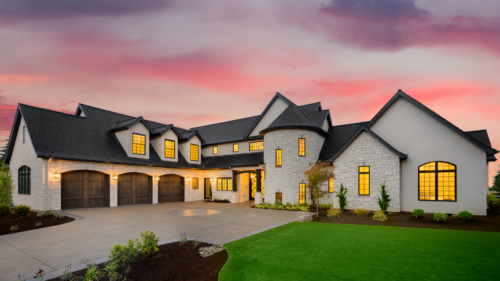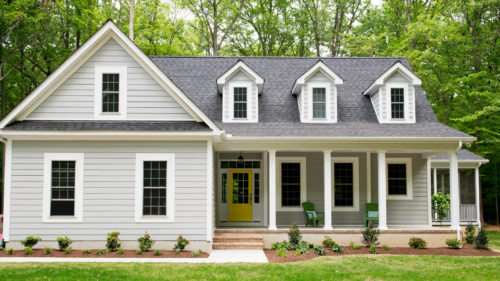Picking the right siding color is more than just making sure it looks good; it plays a big part in how appealing your home looks from the street and can really boost its overall value. With an overwhelming array of options, from classic whites to bold blues, finding that ideal hue can seem daunting. But fear not! Whether you’re aiming to refresh your exterior or planning a complete makeover, understanding current trends and how certain colors complement different architectural styles can make this process exciting rather than overwhelming.
In today’s bustling housing market, where first impressions matter more than ever, selecting the right siding color could be what sets your property apart. Let’s explore some top picks and insider tips to ensure your home stands out—for all the right reasons.
The Ultimate Guide to Choosing Your Siding Color in 2025
Understanding the Basics of Siding Colors
Choosing the right siding color is a big decision. It’s not just about what looks good now, but what will still look amazing years down the road.
The most popular vinyl siding colors in 2025 run the gamut from classic neutrals to bold, eye-catching hues. Think timeless whites, grays, and browns alongside fresh greens, blues, and even pale yellows.
But before you fall in love with a color, there are some key factors to consider:
- Your home’s architecture and style
- The amount of natural light your house gets
- Your landscape and surrounding environment
- Any neighborhood or HOA color restrictions
- Your personal taste and design goals
Taking the time to weigh these elements will help ensure you choose a color you’ll love for the long haul.
Popular Siding Colors for 2025
What’s trending in the world of exterior color palettes? Here are some of the hottest color options we’re seeing for 2025:
- Classic whites and creams for a clean, timeless look
- Grays in every shade, from pale smoke to deep charcoal
- Earthy browns and taupes for a natural, grounded feel
- Coastal blues and greens that evoke serenity
- Soft yellows and greens for a cheerful, welcoming vibe
The key is choosing a color that not only speaks to you, but enhances your home’s best features and meshes with its surroundings. That’s the secret to major curb appeal.
How to Match Siding Colors with Your Home’s Architectural Style
Complementing Traditional and Modern Homes
Your home’s architecture is one of the biggest factors in picking the perfect siding color. A hue that looks stunning on a sleek contemporary home might clash with a cozy craftsman cottage.
For traditional styles like Colonial, Cape Cod, and Victorian, you can’t go wrong with classic white, taupe, or soft gray siding. These timeless neutrals play well with classic architectural details.
On the flip side, modern and minimalist homes often shine in bolder, moodier colors like deep gray, navy blue, or rich brown. These striking hues highlight the clean lines and geometric shapes common in contemporary architecture.
Accentuating Features with Color
The right siding color can also play up your home’s unique features and details. For instance, a pale gray or taupe can make intricate Victorian trim pop, while a warm honey brown can cozy up a farmhouse’s welcoming porch.
Don’t be afraid to mix and match colors, either. A coastal blue paired with crisp white trim is a beach house classic, while a deep gray with black accents adds drama to a modern home. The trick is to mix and match elements that shine a spotlight on your home’s top features.
Maximizing Curb Appeal with Strategic Siding Color Choices
Enhancing Visual Appeal Through Contrast and Harmony
The key to knockout curb appeal? Striking that perfect balance between contrast and harmony in your color scheme.
A pop of bold color on the front door or shutters can add visual interest and depth, especially against a neutral backdrop like classic white or warm taupe siding. Just be sure to echo that accent color in smaller doses elsewhere on the exterior to tie it all together.
On the flip side, a monochromatic palette of closely related shades, like light and medium grays or creams and tans, creates a sense of harmony and cohesion. Especially when we’re talking about bigger homes or ones with lots of intricate design details, this strategy shines.
Selecting Colors for Different Types of Materials
The type of siding material you choose also impacts your color options. For instance, vinyl siding comes in a wide array of hues, from pale pastels to rich earth tones, while fiber cement often has a more curated color palette.
Brick, stone, and wood siding also have their own natural color variations to consider. A cool gray might look crisp and modern next to sleek metal siding, but could feel stark against warm red brick. Always take into account the undertones and inherent colors of any existing exterior materials when selecting your siding hue.
Navigating the Palette: From Bold to Subtle Siding Colors
Making a Statement with Dark and Bold Hues
Ready to go bold with your exterior color? Dark colors like charcoal gray, deep blue, or rich brown can make a serious style statement, especially on modern or contemporary homes.
These moody hues add depth and dimension, and can even make your home appear smaller or more nestled into its surroundings. Plus, they set the perfect stage for those eye-popping, vivid accent colors on your doors and shutters to really stand out.
Just keep in mind that darker shades absorb more heat and may require more frequent cleaning to keep them looking fresh. They also tend to show fading and wear more quickly than lighter, more forgiving colors.
Opting for Light and Neutral Shades for a Subtle Look
Prefer a softer, more understated look? You can’t go wrong with a classic light color like crisp white, creamy off-white, or pale yellow. These timeless hues work well on virtually any home style and are easy to dress up with colorful accents.
Light neutrals like tan, taupe, and gray are also smart choices, as they hide dirt and wear better than stark white while still feeling fresh and clean. They also offer more warmth and depth than a true white.
If you do opt for a light or neutral siding color, consider adding a bold front door or eye-catching landscaping for a pop of visual interest. A little contrast goes a long way in upping that all-important curb appeal factor.
The Role of Lighting and Environment in Selecting Siding Color
How Natural Light Affects Your Siding Color Choice
The amount of natural light your home gets plays a huge role in how your siding color looks. And it’s not just about the time of day either.
Darker colors tend to absorb more heat, which can affect your home’s energy efficiency, especially in warmer climates. Lighter colors, on the other hand, reflect heat and are generally easier to maintain, as they show less dirt and wear over time.
Assess your climate, your willingness to perform regular maintenance and your energy efficiency goals when making the final decision.
Combining Siding Colors with Trim for a Cohesive Look
Classic Combinations That Never Fail
You can truly boost your house’s appeal by choosing the right house siding and trim color combinations. Most designers recommend a strong contrast between the field (siding) and the trim color.
But some homeowners do not want that much contrast and will opt for more neutral colors. It’s really up to you and your tastes, but the following information can help you avoid clashing colors.
A colorful vinyl siding paired with white trim, ranging from warm to cool, is another popular formula that continues to stand the test of time. “The most popular trim color remains white,” says Lechner.
Future-Proofing Your Home’s Exterior with Timeless Siding Colors
Choosing Versatile Colors That Stand the Test of Time
Sure, picking a siding color that catches your eye is important, but don’t forget to weigh the practical aspects too. Reflect on maintenance requirements, long-term durability and energy efficiency.
Keep in mind that siding is a long-term investment, and the color you choose will likely stay with your home for many years. Consider how the color will age and whether it will still be appealing to you and potential future buyers.
From matching your color preferences with your style of home, we can provide you with the guidance you need to see a successful outcome. Contact us today and let’s talk about your siding project.
Siding Color FAQs:
What is the most popular siding color?
Classic white leads the pack. It’s a timeless choice that boosts curb appeal and pairs well with any home style.
What color siding fades the least?
Tan or beige holds up best against sun exposure. These shades stay true longest, reducing maintenance hassles.
What is the most popular siding today?
Vinyl siding wins for popularity. It’s affordable, durable, and comes in many colors. Plus, it’s easy to maintain.
What is the trend in vinyl siding in 2025?
In 2025, dark hues like deep blues and greens are trending. They give homes a modern edge while maintaining classic charm.
Conclusion
The journey through picking the right siding color might have seemed like navigating uncharted waters at first. So, here we are, all the wiser and geared up to make choices that not only amp up our home’s look but also its value. Remember, whether you lean towards serene neutrals or decide to shake things up with something bold, ensuring it reflects both personality and harmony with its surroundings is key. Get started today by requesting free siding quotes!




